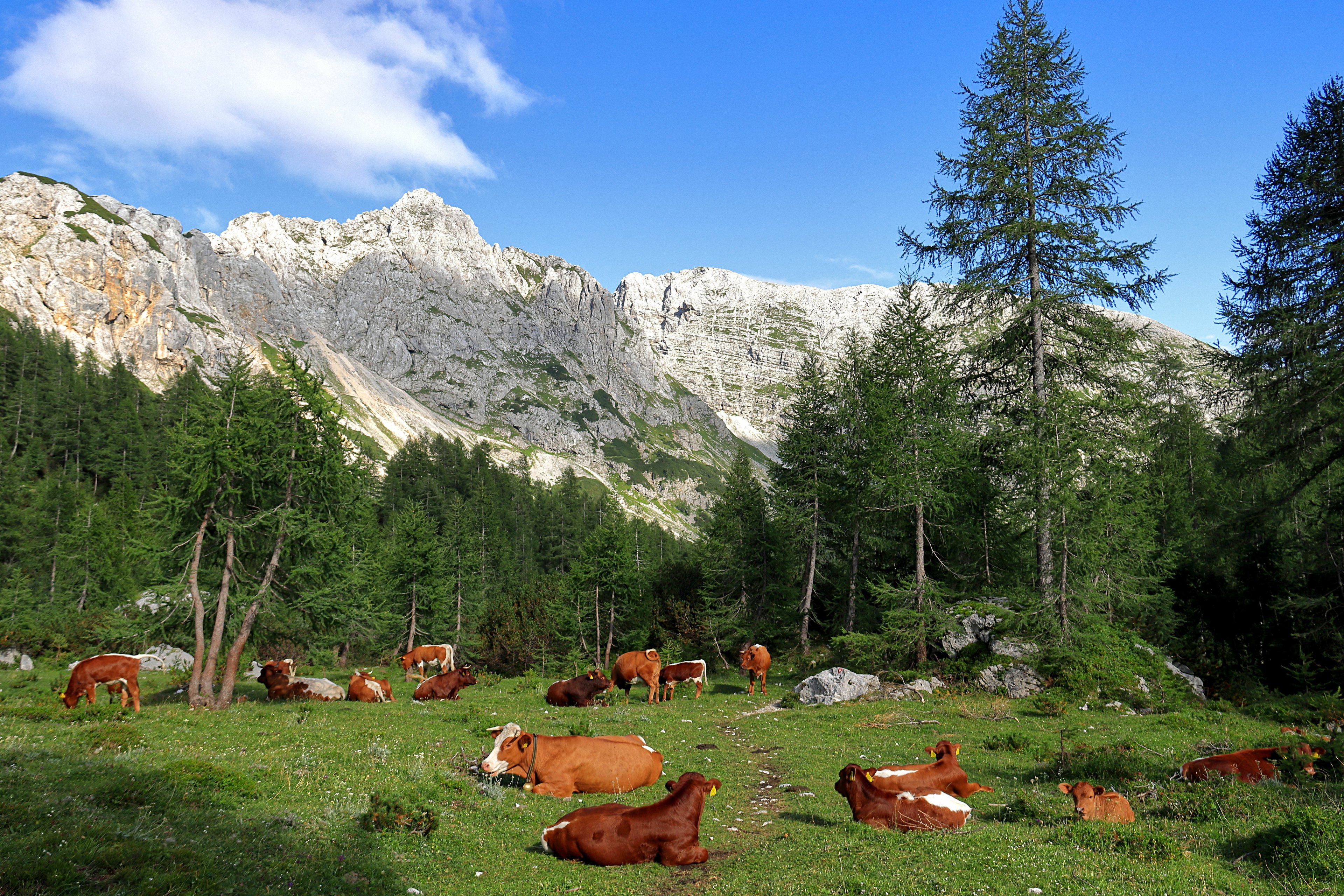About Triglav National Park
Everything about Slovenia's Triglav National Park in one place.

Quick links
Named after our highest mountain, Triglav National Park spans over 840 km2, which translates to 4% of Slovenia’s territory and most of the country’s Julian Alps. Our only national park was established in 1981, but the park’s beautiful mountainous landscape with its sharp peaks, pristine lakes, high karst plateaus, glacier-made valleys and crystal-clear waters is over 200 million years old and home to over 7,000 animal species and 1,600 types of plants. TNP is Slovenia's most popular destination for locals and tourists from all over the world, with its natural beauty and impressive history making it one worth visiting.
Among the many of the Park’s highlights, you can find the Lake Bohinj, Triglav Lakes Valley, Peričnik Waterfall, Pokljuka Plateau, Soča River, Tolmin Gorge, an endless amount of peaks with scenic views all around the park.

The Triglav National park is a place where you can find many authentic alpine villages, that offer delicious cuisine made from local produce. Towns like Bovec, Kranjska Gora and Kobarid supply sports activities, excellent accommodations (hotels, camps, glamping, mountain huts), restaurants and museums. There is always something interesting to discover in and around these places, nestled within surreal surroundings.
The Beginnings
Although the name has been first used in 1926, its history stretches back to the beginning of the 20th century. In year 1906, Slovenian all-around scientist Albin Belar proposed a protected area of the Triglav Lakes Valley, but the idea for a first park of such kind in Europe was turned down.
The idea didn’t reemerge until after the 1st World War, when the strategic basis for this piece of the land, titled the Memorandum was submitted to the Provincial Government of Slovenia in 1920.
The idea was finally implemented in 1924, when the Alpine Conservation Park was founded, which protected the area around the Seven Lakes Valley. It was made possible by an initiative by the Nature Protection Section of the Slovene Museum Society together with the Slovene Mountaineering Society for a twenty-year lease taken on the Triglav Lakes Valley area.
The name “Triglav National Park” was used soon after in 1926, by a botanist and a plant geneticist Fran Jesenko.

In 1961, the protection act was renewed and the name of the park was changed to Triglav National Park. Even though it held the name of our highest mountain, the park only protected the wider area of the Triglav Lakes Valley, from Kanjavec peak to Savica Waterfall.
Finally, in 1981, the Law of the Triglav National Park was passed and its present borders, containing most of the Julian Alps, were outlined. From the 20 square kilometres protected at first, it enlarged to an area of 840 square kilometres it covers nowadays.
TNP’s vision mission
The priority objectives of the park are conservation of ecosystems and natural processes, natural assets, diversity of habitats, plant and animal species, landscape quality and landscape diversity. In the park’s area which is settled, the main focus is to safeguard the cultural heritage and quality of land, which arose from the harmony between man and nature.
Nature’s wellbeing is our responsibility
The Park wants to provide you with a rich experience of its natural beauty, but remember – we are all just guests of this highly sensitive natural environment, so when we pay it a visit, we must take on the responsibility to help maintain its state of preservation.
Here are the most important rules of conduct in the Park:
- Park your vehicle in one of the many designated car parks.
- Stay on the marked trails and keep your noise levels down to not disturb the animals.
- Dogs must be kept on a leash.
- Respect the flora and fauna. You can experience TNP’s richness up-close, but make sure your presence does not disturb their lives.
- Observe a sky full of stars from benches outside mountain huts, lodges, shelters and bivouacs. Camping or bivouacking outside designated areas is forbidden.
- Take only memories and leave only footprints behind – do not pick flowers and take the trash with you
A Paradise for Outdoor Enthusiasts
With its towering mountains, scenic valleys, pristine waters, peaceful forests and rich cultural heritage, the Triglav National Park is a wonderland of outdoor activities and must-see places. The most popular of those activities is hiking, which is presented in more detail in “Hiking in Triglav National Park”.

Water Activities in Triglav National Park
The Park is home to more than 250 springs of various sizes, numerous alpine lakes, Slovenia’s largest natural lake Bohinj, a broad network of rivers and streams, wetlands and bogs. It’s also where two important European rivers emerge, the Sava and the Soča River.
These bodies of water make the park a perfect spot for many kinds of recreational activities in the water like swimming, kayaking, rafting, canyoning, fishing or more. But remember, swimming in the high-altitude lakes like the ones in Triglav Lakes Valley is strictly forbidden since it deteriorates their biosphere.
Rock Climbing in Triglav National Park
The Park is home to numerous natural climbing areas of various difficulties. For those that still getting used to rock climbing, one of the options would be Peč, near lake Bohinj, which has 56 routes, suitable for people less and more familiar with the sport. Another option is a wall in Trenta valley, rising next to the Soča River. It has two boulders equipped with 27 directions for both beginners and experienced climbers.
For those wanting to test themselves more, the Blažec rock wall offers up to 80 meters long directions with multiple pitches and a view of the Vrata Valley. For climbing at a higher altitude, drive up to the 1611 meters high Vršič pass and try out some of the 35 routes they have there, which are between 18 and 100 meters long.
Winter Sports in Triglav National Park
During the winter season, TNP is transformed into a snowy paradise straight out of a fairy-tale. Snowshoeing in the Tamar Valley or cross-country skiing along the pastures of Pokljuka Plateau is a must. The winter tourism hub of Kranjska Gora offers diverse alpine skiing opportunities and the high-altitude Vogel ski resort can be one of your only chances to try skiing above the clouds. Just one step from Vogel, the Julian Alps offer endless options for ski-touring. For those more adventurous, there are many icefalls frozen in the winter, as well as a beginner-friendly ice arena.
Other Sports Activities in Triglav National Park
The activities listed above are the most popular, but the varied and dynamic terrain of the park also makes it an excellent place for mountain biking, cross-country-running, paragliding and caving.
Useful Tips for TNP Visitors
When to visit?
Triglav National Park is a fantastic place to visit all year round with each season adding a special charm to the place. Hiking in the valleys, hills or lower valleys can be done from spring to autumn, sometimes even winter. Ascending higher peaks is best done in summer since the snow is mostly melted. If you want stable weather with the least afternoon storms possible, September is the month to go.
What to pack?
If you won’t just stick to the valley, it’s best to pack some warmer layers of clothing since temperature changes are quite common in the Julian Alps. Even though you might not feel its warmth, the sun’s UV strength increases by more than 30 % for each additional 1000 metres of elevation you reach. That means it’s much easier to get sunburnt in the mountains, so you shouldn’t forget to put on your sunscreen and bring your sunglasses.
For more tips related to hiking in the Triglav National Park, check out our Ultimate Guide.
Staying in the park
Accommodation options in the Park can satisfy any kind of visitor. From camping and glamping sites, to hotels, tourist farms, and of course, mountain huts. Options are plenty, but they can be full if you arrive without a prior reservation, so we highly advise you to book in advance.
The region is the most popular destination among locals and foreigners, especially between April and September. Since the mountain huts capacity is limited, booking them at least a month in advance is your best bet to get a room.
Guides help you explore more easily
The most optimal way of exploring the wonders in the Triglav National Park is through organised tours. Professional guides show you the best locations, show you hidden gems, offer support and supply tips. A local guide can also make it much easier by helping you book accommodations and handle logistics.

Accessibility
Road connectivity throughout all of Slovenia is fantastic, and Triglav National Park is no exception. There may be some differences in transfer times between seasons, but the Park can be reached in a maximum of 2h30 from the farthest part of the country – it’s less than an hour away from the capital of Ljubljana.
There are also plenty of designated park spaces at the major attractions, but to keep it even more ecological, make use of the frequent and reliable public transport options. Of course, for a relaxing trip without any stress, organized excursions are your best option. But consider taking your time and enjoying the Park on foot through multi-day hikes in the area.
For ideas about that, check out Triglav National Park tours >

Expert Local Guides
Our professional guides know the local terrain and are trained to make this once-in-a-lifetime opportunity both safe and enjoyable.

Hassle-Free
We handle route planning, accommodations, transfers, and anything else you prefer not to deal with, so you can enjoy a carefree hike.

Tried & Tested Adventures
Only the best hiking adventures in Slovenia, cherry-picked by our local team with an in-depth knowledge of the region.

Book with Confidence
We are a financially protected company, fully bonded and insured, keeping your money safe and allowing you to travel with confidence.

Unbeatable Support
Our 24/7 customer support is where we show our passion, bringing you a better experience by making your well-being our number one priority.

